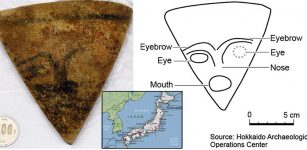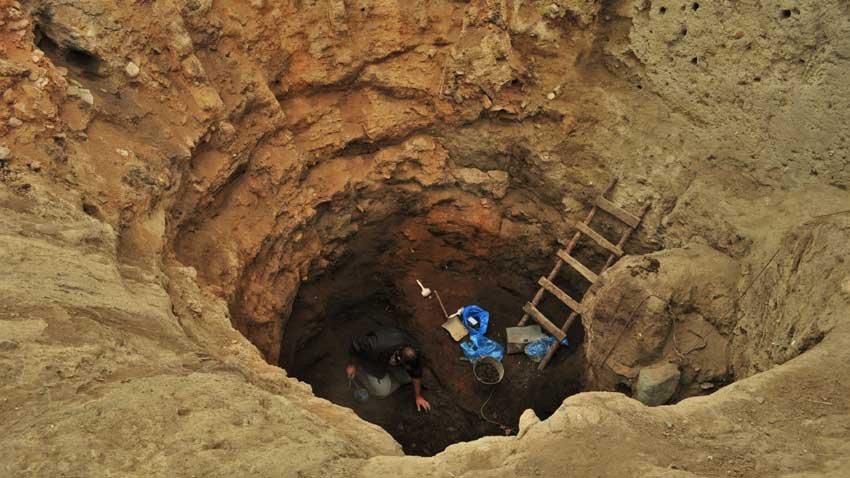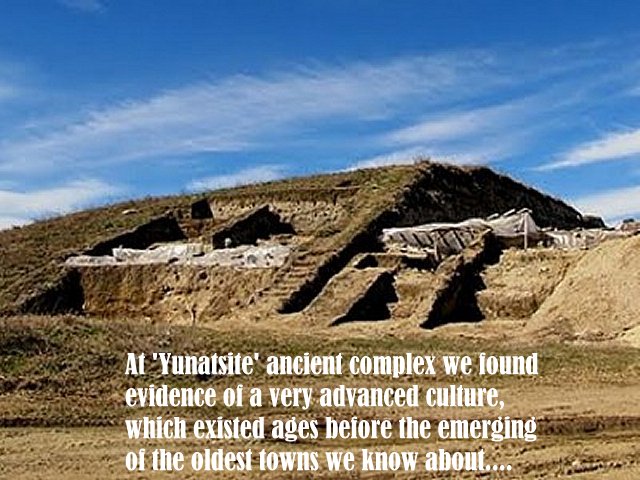‘Yunatsite’ And Thought-Provoking Theory That Balkan Peninsula And Not Mesopotamia Was The Cradle Of Civilization
A. Sutherland - AncientPages.com - More and more evidence confirms a very brave thesis: the Balkan Peninsula, rather than ancient Mesopotamia, is the cradle of our civilization.
The evidence of a little-known culture preceding Egyptian and even Sumerian culture has been attracting the attention of researchers, turning everything we know about antiquity upside down.
Tell Yunatsite - Image credit: Ivan Vasilev - CC BY-SA 4.0
Remains of this ancient society had gradually emerged from the ashes of human history, taking us some 6-7 millennia back when a highly advanced unknown civilization flourished in our lands.
This period preceded Sumer and Akkad by at least one millennium.
A vivid testimonial to the existence of this mysterious civilization is the gold from the Chalcolithic Necropolis of Varna (from 4,400-4,100 BC), also known as the oldest processed gold in the world. The earliest traces of human habitation in this region date back to the Old Stone Age, 100,000 years ago.
Image credit: Balkan Heritage Field School: Tell Yunatsite (2013)
Today the magnificent golden relics from the region are admired at some of the most famous museums in the world. The prehistoric settlement near Provadia (Southeastern Bulgaria) dates back to the same period.
Another old place was the so-called Lake Town, situated on the island near the coastal village of Durankulak, where the remains of the oldest stone architecture in Europe were found. It was unearthed near an ancient Black Sea salt pan. Its residents prospered due to the salt, once the basic monetary unit.
It is at least 7,000 years old.

Image credit: Balkan Heritage Field School: Tell Yunatsite (2013)
The village mound near the city of Pazardjik (southern Bulgaria) named "Yunatsite" (which means 'the Heroes') also dates back to that period. Archeologists have been researching this region for years and have found numerous traces of the Chalcolithic period.
Researchers led by Professor Yavor Boyadzhiev are unearthing a four-meter thick fortress wall, which once encircled streets, residential buildings, etc. Researchers believe the place could be the oldest town in Europe. The earliest finds from the mound date back to the 5th millennium BC. The city covered an area of 12-15 hectares. Interestingly, settlements of similar size emerged in the lands between the Euphrates and Tigris rivers some 1,500 years later.
Researchers excavated Mesopotamia's settlements covering an area of 0.7- 0.8 hectares, and these ancient sites are considered towns, according to Boyadzhiev.
"Judging even by Mesopotamian standards, what we have here is an ancient town. The town elite and all craftsmen used to live there. We discovered a big settlement with a citadel at its highest point, the principle on which any ancient town was constructed - the existence of a fortified area inside the town that had to protect its population in the event of an emergency.
The team of Ass. Prof. Boyadzhiev reached the doorway to the citadel. Image credit: Balkan Heritage Field School and Workshops
At the "Yunatsite" ancient complex, we found evidence of a very advanced culture that existed ages before the emergence of the oldest towns we know about. This is an incredible historical monument where life continued from the 5th millennium BC until the Medieval Period, i.e., covering six whole millennia!"
What did this ancient town look like? Archeologists suppose that its inhabitants were mainly living on fishing in the Topolnitsa River nearby, and lived "in cozy houses made of wooden fencing plastered up with clay, rather than in huts. Their homes covered an area of 80-120 square meters. There were two-story buildings, too.
Image credit: Balkan Heritage Field School and Workshops
Archaeologists unearthed ceramic fragments at the site of the excavations.
“These houses did not differ much from the ones built in Bulgarian villages 70-80 years ago,” Associate Professor Boyadzhiev explains. The ceramic pieces found here, including dozens of fantastic figurines of birds, were displayed at the Museum of History in the town of Pazardzjik...", according to source.
Updated on November 5, 2023
Written by A. Sutherland – AncientPages.com
Copyright © AncientPages.com All rights reserved. This material may not be published, broadcast, rewritten or redistributed in whole or part without the express written permission of AncientPages.com
Expand for referencesMore From Ancient Pages
-
 Iron Age Site Tell Deir ‘Alla (“Mound Of The High Monastery”) Flourished 400 Years In Central Jordan Valley
Archaeology | Jul 25, 2022
Iron Age Site Tell Deir ‘Alla (“Mound Of The High Monastery”) Flourished 400 Years In Central Jordan Valley
Archaeology | Jul 25, 2022 -
 Will Star Goddess Astraea Return To Earth With Second Golden Age Or Apocalypse?
Featured Stories | Aug 1, 2020
Will Star Goddess Astraea Return To Earth With Second Golden Age Or Apocalypse?
Featured Stories | Aug 1, 2020 -
 Ancient Roman Altarpieces Deciphered And New Roman Goddess Uncovered In The Netherlands
Archaeology | Jun 18, 2024
Ancient Roman Altarpieces Deciphered And New Roman Goddess Uncovered In The Netherlands
Archaeology | Jun 18, 2024 -
 Mysterious Kallerup’s Double-Headed Figurine – Evidence Of Unknown Norse God Or Worship Of Roman God Janus In Ancient Scandinavia?
Artifacts | Mar 19, 2020
Mysterious Kallerup’s Double-Headed Figurine – Evidence Of Unknown Norse God Or Worship Of Roman God Janus In Ancient Scandinavia?
Artifacts | Mar 19, 2020 -
 Evidence Of An Ancient Roman Oracle Cult Found In Ostia, Italy
Archaeology | Jun 18, 2024
Evidence Of An Ancient Roman Oracle Cult Found In Ostia, Italy
Archaeology | Jun 18, 2024 -
 Who Has Stolen Charles Darwin’s Notebooks Worth Millions From The University Of Cambridge?
News | Nov 24, 2020
Who Has Stolen Charles Darwin’s Notebooks Worth Millions From The University Of Cambridge?
News | Nov 24, 2020 -
 Why Did Modern Humans Replace The Neanderthals? The Key Might Lie In Our Social Structures
Featured Stories | Jun 18, 2024
Why Did Modern Humans Replace The Neanderthals? The Key Might Lie In Our Social Structures
Featured Stories | Jun 18, 2024 -
 Jomon Period: Triangle-Shaped Stone Artifact Depicting Human Face Found For The First Time In Japan
Archaeology | Dec 25, 2017
Jomon Period: Triangle-Shaped Stone Artifact Depicting Human Face Found For The First Time In Japan
Archaeology | Dec 25, 2017 -
 Unknown Prehistoric Henge Site Detected Near Famous Newgrange In Ireland’s East Coast
Archaeology | Jul 13, 2018
Unknown Prehistoric Henge Site Detected Near Famous Newgrange In Ireland’s East Coast
Archaeology | Jul 13, 2018 -
 Unexplained Mystery Of The Untraceable Stone-Throwers – Strangeness In North America, Belgium And Indonesia – Part 1
Featured Stories | Nov 11, 2019
Unexplained Mystery Of The Untraceable Stone-Throwers – Strangeness In North America, Belgium And Indonesia – Part 1
Featured Stories | Nov 11, 2019 -
 Ancient Mysteries Of Wisconsin – Great Forgotten Prehistoric Events Shed New Light On History Of North America
Featured Stories | Jan 11, 2019
Ancient Mysteries Of Wisconsin – Great Forgotten Prehistoric Events Shed New Light On History Of North America
Featured Stories | Jan 11, 2019 -
 Ancient Underwater City Of Heracleion Reveals More Archaeological Treasures
Archaeology | Jul 21, 2021
Ancient Underwater City Of Heracleion Reveals More Archaeological Treasures
Archaeology | Jul 21, 2021 -
 Unique 2,000-Year-Old Hexagonal-Shaped Bronze Matrix Of Sarmizegetusa Regia, Romania
Artifacts | Jan 7, 2016
Unique 2,000-Year-Old Hexagonal-Shaped Bronze Matrix Of Sarmizegetusa Regia, Romania
Artifacts | Jan 7, 2016 -
 World’s Oldest Wine Found In 2,000-Year-Old Roman Tomb In Carmona, Spain
Archaeology | Jun 19, 2024
World’s Oldest Wine Found In 2,000-Year-Old Roman Tomb In Carmona, Spain
Archaeology | Jun 19, 2024 -
 European Neolithic Family Trees Shed Light On Social Organization
Archaeology | Jul 27, 2023
European Neolithic Family Trees Shed Light On Social Organization
Archaeology | Jul 27, 2023 -
 Urartian Noble Woman Buried With Jewelry Found In 2,750-Year-Old Necropolis Of Çavuştepe Castle
Archaeology | Sep 10, 2020
Urartian Noble Woman Buried With Jewelry Found In 2,750-Year-Old Necropolis Of Çavuştepe Castle
Archaeology | Sep 10, 2020 -
 Ancient Mysteries Of Chicago: Is The Puzzling Waubansee Stone A Neglected Pre-Columbian Artifact?
Artifacts | Mar 4, 2017
Ancient Mysteries Of Chicago: Is The Puzzling Waubansee Stone A Neglected Pre-Columbian Artifact?
Artifacts | Mar 4, 2017 -
 On This Day In History: Storming Of The Paris Fortress – Prison Bastille – On July 14, 1789
News | Jul 14, 2016
On This Day In History: Storming Of The Paris Fortress – Prison Bastille – On July 14, 1789
News | Jul 14, 2016 -
 Victory Tower – An Imposing Victory Monument In Chittorgarh, Rajasthan, India
Civilizations | Jul 28, 2015
Victory Tower – An Imposing Victory Monument In Chittorgarh, Rajasthan, India
Civilizations | Jul 28, 2015 -
 Unraveling The Mystery Of How Our Ancestors Created The First Spoken Words
Archaeology | Dec 6, 2021
Unraveling The Mystery Of How Our Ancestors Created The First Spoken Words
Archaeology | Dec 6, 2021






